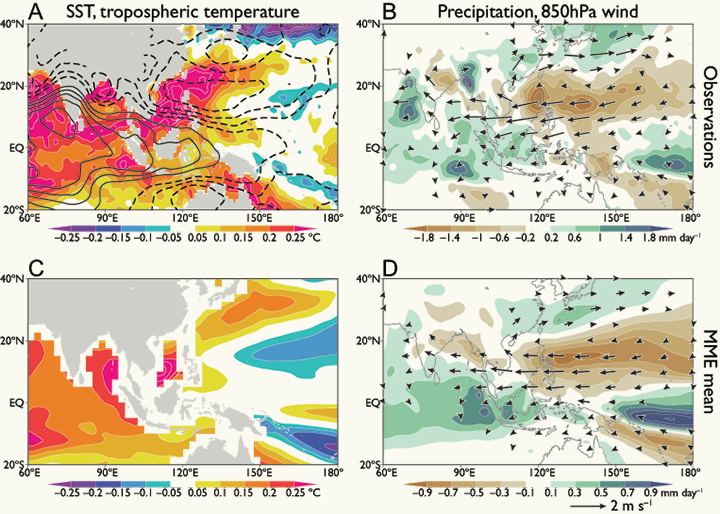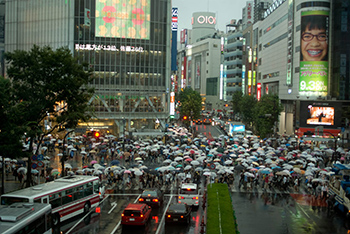The Asian Monsoon is Getting Predictable
Researchers find strong correlation between summer monsoon and the climate pattern that preceded it
By:
- Robert Monroe
Published Date
By:
- Robert Monroe
Share This:
Article Content
For much of Asia, the pace of life is tuned to rhythms of monsoons.
The summer rainy season is especially important for securing the water and food supplies for more than a billion people. Its variations can mean the difference between drought and flood. Now a Scripps Institution of Oceanography, UC San Diego-led study reports on a crucial connection that could drastically improve the ability of forecasters to reliably predict the monsoon a few months in advance.

Researchers studied anomalies of observed (a) and modeled (c) Indian Ocean sea-surface temperatures as well as observed (b) and modeled (d) precipitation patterns to establish a link between El Niño and the Asian monsoon. Image by PNAS.
Yu Kosaka and Shang-Ping Xie from Scripps and colleagues from NOAA found that a winter appearance of the climate phenomenon called El Niño in the Pacific Ocean can leave its mark on monsoon formation in the Indian Ocean a full six months later. In between is an atmospheric phenomenon called the Pacific-Japan pattern that provides the teleconnection between the two ocean basins and further poleward to East Asia.
“It has long been a mystery that climate anomalies in the region correlate better with El Niño in the preceding winter than with the one developing in the concurrent summer,” said Xie, a climate scientist and inaugural holder of the Scripps Roger Revelle Chair in Environmental Science. “The new paper shows that Indian Ocean temperature and atmospheric anomalies in the western Pacific are physically coupled, and their interactions amplify each other. We demonstrated that this new mode of coupled ocean-atmospheric anomalies is predictable a season ahead. Such predictions have tremendous benefits to society.”
The National Science Foundation-funded study, “Origin of seasonal predictability for summer climate over the Northwestern Pacific,” appears online on April 22 in Proceedings of the National Academy of Sciences. Ngar-Cheung Lau and Gabriel Vecchi of NOAA are also co-authors.
El Niño is a climate phenomenon coupling the ocean and atmosphere that includes a shift in the distribution of warm water in the equatorial Pacific Ocean. El Niño years are characterized by unusual weather and storm activity globally.

Japanese pedestrians in a rainstorm.
The summer after a major El Niño features above-average sea-surface temperatures in the Indian Ocean. El Niño exerts its influence via the Pacific-Japan pattern, which can bring to East Asia cool, wet weather in the subsequent summer, while La Niña leads to dry, hot weather.
The violent storm activity associated with El Niño takes place in the eastern Pacific Ocean, but the chain of events the researchers describe ultimately ends up being detected in the western Pacific Ocean. Xie likened it to an echo effect, saying that El Niño serves to pull clouds and convection eastward toward the International Date Line, which means those clouds are not available over the western Pacific to keep ocean surface temperatures cool. It also weakens winds in the northern Indian Ocean and the effects of those weakened winds travel back eastward to the Pacific Ocean.
“The last sound El Niño makes is in the western Pacific Ocean,” Kosaka said, “because the positive feedback between the Indian Ocean and Pacific-Japan pattern we found amplifies climate anomalies in this region.”
The last echoes of El Niño have devastating consequences to the region.
Extremes in the East Asian summer monsoon have been behind some of the largest natural and economic disasters to hit the region in the last 20 years. The authors note that excessive rains and cool temperature in Japan in 1993 caused a widespread failure of that country’s rice crop that opened it to imports from other countries. Dry monsoon phases led to widespread heat waves and drought in several East Asian countries in 2004.
Kosaka cautioned, however, that there is much more work to be done to make prediction of the Asian monsoon reliable. El Niño is just one factor; other regional patterns complicate the sequence that ultimately produces monsoon rains, Kosaka said.
But the paper does establish that El Niño influences the monsoon and describes the means by which it does so, she said.
Share This:
You May Also Like
UC San Diego is Strengthening U.S. Semiconductor Innovation and Workforce Development
Technology & EngineeringStay in the Know
Keep up with all the latest from UC San Diego. Subscribe to the newsletter today.



